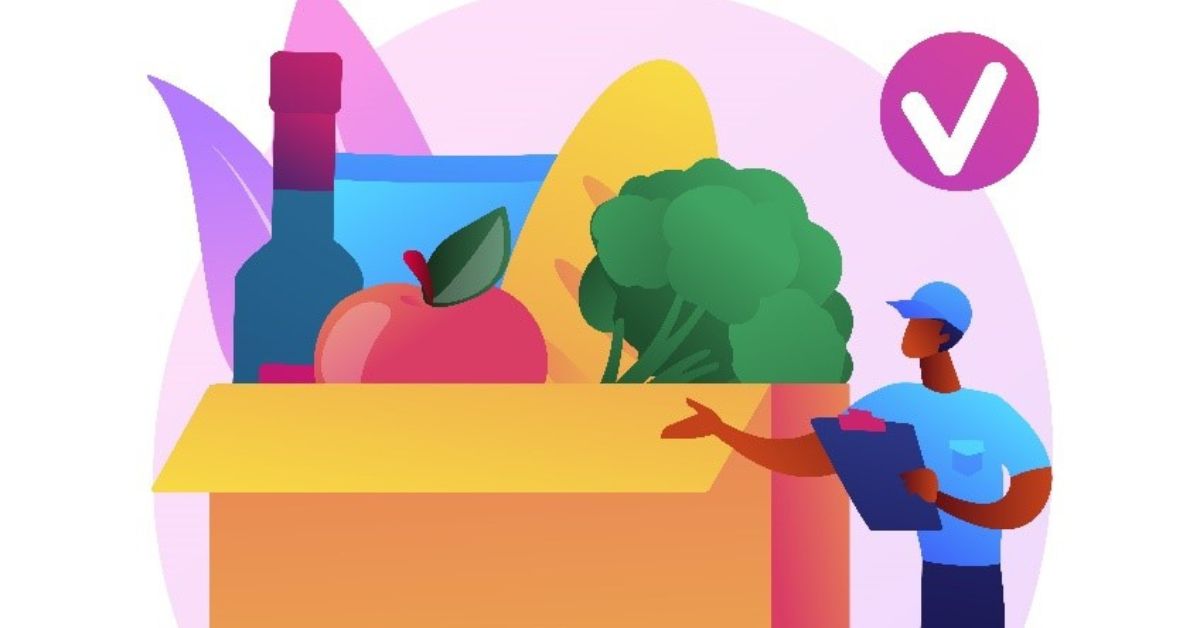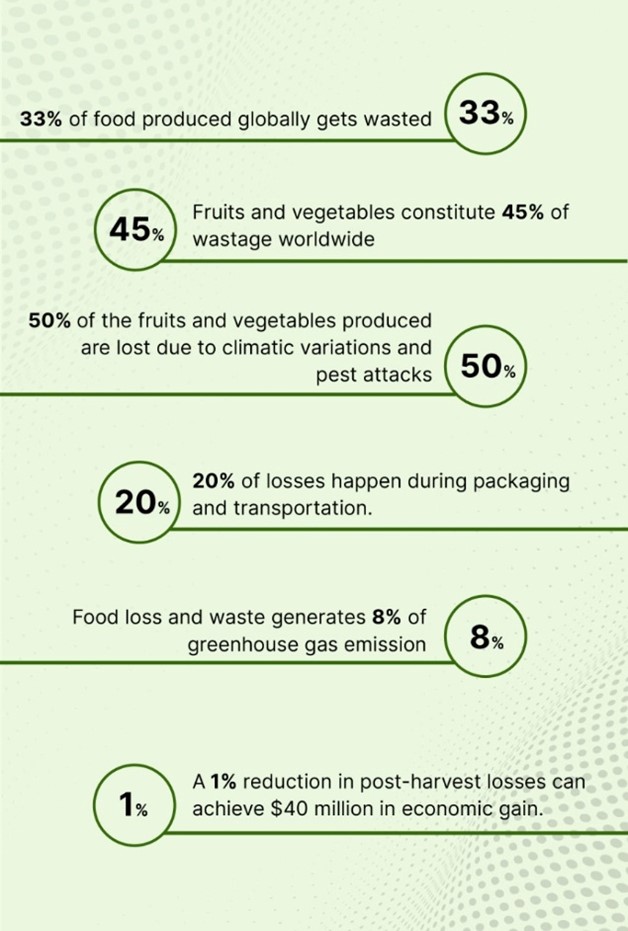Contact: +91 99725 24322 |
Menu
Menu
Quick summary: Discover the importance of traceability in the fruit and vegetable supply chain. Explore how traceability solutions like TraceX ensure safety, quality, and sustainability. Gain insights into enhancing consumer trust and optimizing supply chain efficiency.

Amidst growing concerns over food safety, sustainability, and ethical sourcing, traceability emerges as a beacon of transparency and accountability. Traceability in the fruit and vegetable supply chain not only enables stakeholders to track the journey of produce from its origin but also empowers them to uphold quality standards, mitigate risks, and foster consumer trust.
According to WHO, an estimated 600 million people globally fall ill and 420,000 die every year due to food contamination.
India is the second-largest producer of fruits and vegetables in the world. The diverse climate, availability of natural resources, urbanization, and changing lifestyles are favoring the growth of fruit and vegetable supply chains for the future.
According to Verified Market research, the fresh fruit and vegetable market size which was valued at USD 144 million in 2020 is projected to reach USD 211 million by 2028, growing at a CAGR of 5.14%.
The demand for healthy and nutritious food is also driving this food sector. India has the potential of becoming a leading supplier of fruits and vegetables both in the local and global markets. Building agile, robust, and efficient fruit and vegetable supply chains is the need of the hour to address food safety challenges.

The journey of fruits and vegetables from pre-harvest to fork encompasses a series of critical stages, each playing a pivotal role in ensuring the quality, safety, and sustainability of produce.
It all begins with meticulous pre-harvest preparations, where farmers assess soil health, select appropriate crops, and implement cultivation practices tailored to specific fruits and vegetables. Factors like irrigation, pest management, and fertilization are carefully monitored to optimize yield and quality.
Once seeds are sown or seedlings transplanted, fruits and vegetables undergo a period of growth, influenced by environmental factors like temperature, sunlight, and moisture. Farmers employ sustainable farming practices to nurture healthy crops, minimizing the use of chemical inputs and maximizing natural resources.
Harvesting marks the culmination of months of labor, as ripe fruits and vegetables are carefully handpicked or mechanically harvested, depending on the crop. Timing is crucial to ensure peak ripeness and flavor, with skilled workers selectively harvesting produce to minimize damage and preserve quality.
Immediately after harvest, fruits and vegetables undergo post-harvest handling processes to maintain freshness and extend shelf life. This includes washing, sorting, grading, and packaging, often done within designated facilities equipped with state-of-the-art technology to minimize contamination and maximize efficiency.
From packing facilities, fruits and vegetables embark on a journey through a complex network of transportation modes, including trucks, trains, ships, and airplanes. Cold chain logistics play a crucial role in preserving perishable produce during transit, ensuring it reaches its destination in optimal condition.
Upon reaching retail outlets, fruits and vegetables are meticulously displayed to entice consumers, with quality standards maintained throughout the supply chain. From supermarkets to farmers’ markets, consumers are presented with a diverse array of fresh produce, often accompanied by information on origin, variety, and nutritional benefits.
The journey culminates as consumers bring fruits and vegetables into their homes, incorporating them into meals and snacks. Whether enjoyed raw or cooked, fresh produce offers essential nutrients, flavors, and textures, contributing to a balanced diet and overall well-being.
Discover the future of food traceability with blockchain technology.
Learn how blockchain ensures transparency and trust in the food supply chain.
The fruit and vegetable supply chain faces several challenges that impact the quality, safety, and sustainability of produce:
Addressing these challenges requires collaboration among stakeholders across the supply chain, adoption of technology-enabled solutions for traceability and efficiency, implementation of best agricultural practices, and commitment to sustainability and food safety standards.
The creation of a robust seed-to-shelf traceability for the fruit and vegetable supply chain by incorporating technology will link together the farmers and the other actors in the supply chain to ensure the availability of safe and quality produce to the end consumer. The growing problems on food safety due to disease outbreaks and food contamination necessitate product recalls to ensure public health. Targeting these food recalls is crucial to take immediate action and prevent wastage and economical losses.
The solution to these problems is.
TraceX Farm Management Software plays a pivotal role in driving traceability and sustainability in the fruit and vegetable supply chains. Trace Gro streamlines pre-harvest management with crop planning, monitoring, and input management, while Trace Pro enhances post-harvest management through inventory tracking, quality control, and distribution management, ensuring efficiency and quality at every stage of the supply chain.
Batch-Level Traceability– TraceX enables growers to meticulously track each batch of produce from farm to fork, recording crucial data points such as planting dates, cultivation practices, harvest times, and post-harvest treatments. This granular traceability ensures transparency and accountability throughout the supply chain, facilitating rapid identification and mitigation of quality and safety issues.
Compliance Management-The software helps farmers adhere to regulatory requirements and industry standards by providing tools for monitoring and documenting compliance with food safety regulations, environmental regulations, and sustainability certifications. By ensuring compliance at every stage of production, TraceX mitigates risks associated with non-compliance and strengthens the reputation of growers in the market.
Resource Optimization – TraceX optimizes resource utilization by offering insights into crop health, soil fertility, and water usage through data analytics and predictive modeling. By identifying inefficiencies and opportunities for improvement, farmers can implement precision farming techniques, minimize inputs, and reduce environmental impact while maximizing yield and quality.
Supply Chain Visibility – Through integration with supply chain partners and stakeholders, TraceX enhances visibility and collaboration across the entire supply chain. Growers can share real-time data on crop availability, quality metrics, and logistical details with buyers, distributors, and retailers, facilitating informed decision-making and streamlined operations.
Sustainability Reporting – TraceX facilitates sustainability reporting by capturing and analyzing data related to agricultural practices, environmental stewardship, and social responsibility. By quantifying key performance indicators (KPIs) such as carbon footprint, water usage efficiency, and biodiversity conservation efforts, growers can demonstrate their commitment to sustainable agriculture and meet the evolving demands of consumers and regulators.
Continuous Improvement -Leveraging data-driven insights and performance analytics, TraceX empowers growers to continuously improve their farming practices and sustainability performance. By benchmarking against industry standards and best practices, farmers can identify areas for optimization, implement corrective actions, and track progress over time, driving ongoing innovation and resilience in the supply chain.
Overall, TraceX Farm Management Software serves as a catalyst for transforming fruit and vegetable supply chains towards greater traceability, efficiency, and sustainability, aligning with the industry’s evolving priorities and expectations.
In conclusion, traceability is paramount in ensuring the safety, quality, and sustainability of the fruit and vegetable supply chain. By leveraging advanced technologies like TraceX Farm Management Software, stakeholders can effectively track the journey of produce from farm to fork, mitigating risks, reducing waste, and meeting consumer demands for transparency. With a comprehensive traceability system in place, the industry can foster trust among consumers, enhance efficiency, and promote responsible practices that benefit both businesses and the environment. As we move forward, continued efforts to strengthen traceability initiatives will be essential for driving innovation and resilience in the fruit and vegetable supply chain.
